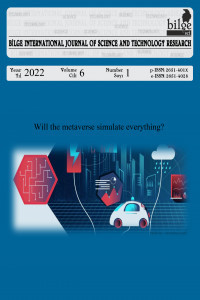Kesir Dereceli Kontrol Sistemlerinde Referans Modele Dayalı PID Kontrolör Tasarımı
PID Kontrolör, Optimizasyon, Kesir dereceli sistemler
PID Controller Design Based on Reference Model in Fractional Order Control Systems
PID Controller, Optimization, Fractional order systems,
___
- Åström, K. J., Hägglund, T. (2001). The future of PID control. Control engineering practice, 9(11), 1163-1175.
- Atherton, D. (2009). Control engineering: Bookboon.
- Battula, K., Reddy, K. (2008). Active and Passive Realization of Fractance Device of Order 1/2 , pp.1-6.
- Bohannan, G. W. (2008). Analog Fractional Order Controller in Temperature and Motor Control Applications. Journal of Vibration and Control, 14(9-10),1487-1498.
- Carlson, G., Halijak, C. (1964). Approximation of fractional capacitors (1/s)(1/n) by a regular Newton process. IEEE Transactions on Circuit Theory, 11(2), 210-213.
- Cervera, J., Baños, A. (2006). Automatic loop shaping in qft by using crone structures. IFAC Proceedings Volumes, 39(11), 207-212.
- Chen, Y., Petras, I., Xue, D. (2009). Fractional order control-A tutorial. Paper presented at the American Control Conference, ACC'09, pp.1397-1411.
- Gutiérrez, R. E., Rosário, J. M., Tenreiro Machado, J. (2010). Fractional order calculus: basic concepts and engineering applications. Mathematical Problems in Engineering, 2010.
- Katsuhiko, O. (2010). Modern control engineering.
- Kuo, B. C. (1987). Automatic control systems: Prentice Hall PTR.
- Lokenath, D. (2003). Recent applications of fractional calculus to science and engineering (Vol. 2003).
- Manabe, S. (1961). The noninteger integral and its application to control systems. English Translation Journal Japan, 6, 83-87.
- Manabe, S. (1963). The system design by the use of a model consisting of a saturation and noninteger integral. English Translation Journal Japan, 47-150.
- Matsuda, K., Fujii, H. (1993). H(infinity) optimized wave-absorbing control - Analytical and experimental results. Journal of Guidance, Control, and Dynamics, 16(6), 1146-1153. Monje, C. A., Chen, Y., Vinagre, B. M., Xue, D., Feliu-Batlle, V. (2010). Fractional-order systems and controls: fundamentals and applications: Springer Science & Business Media.
- Oustaloup, A., Levron, F., Mathieu, B., Nanot, F. M. (2000). Frequency-band complex noninteger differentiator: characterization and synthesis. IEEE Transactions on Circuits and Systems I: Fundamental Theory and Applications, 47(1), 25-39.
- Panda, R., Dash, M. (2006). Fractional generalized splines and signal processing. Signal Processing, 86(9), 2340-2350.
- Pu, Y.-F., Yuan, X., Liao, k., Zhou, J., Ni, Z., Pu, X., Zeng, Y. (2006). A recursive two-circuits series analog fractance circuit for any order fractional calculus - art. no. 60271Y (Vol. 6027).
- Tustin, A., Allanson, J., Layton, J., Jakeways, R. (1958). The design of systems for automatic control of the position of massive objects. Proceedings of the IEE-Part C: Monographs, 105(1S), 1-57.
- Xue, D., Zhao, C., Chen, Y. (2006, 25-28 June 2006). A Modified Approximation Method of Fractional Order System. Paper presented at the 2006 International Conference on Mechatronics and Automation.
- Ziegler, J. G., Nichols, N. B. (1942). Optimum settings for automatic controllers. trans. ASME, 64(11).
- ISSN: 2651-401X
- Yayın Aralığı: Yılda 2 Sayı
- Başlangıç: 2017
- Yayıncı: Kutbilge Akademisyenler Derneği
Mete Yağanoğlu, Murat Kayabekir, Cemal KÖSE
Bilişsel Radyo Sistemleri için Özdeğer Tabanlı Algılama Yöntemlerinde Performans Analizi
Cebrail ÇİFLİKLİ, Fatih Yavuz ILGIN
Sercan BULBUL, Cevat INAL, Omer YILDIRIM, Fuat BASCIFTCI
Yapay Sinir Ağları ile Tr81 Bölgesi Yıllık Elektrik Enerjisi Tüketiminin Tahmini
Yasemin KOCADAYİ, Okan ERKAYMAZ, Rukiye UZUN
Authentication with Iris Recognition Based on A 3-Tier Security Analysis Approach
Kesir Dereceli Kontrol Sistemlerinde Referans Modele Dayalı PID Kontrolör Tasarımı
Tufan DOĞRUER, Ali YÜCE, Nusret TAN
Development of the road analysis system to provide the fuel efficiency awareness in the vehicles
Bakır Esaslı Rodaj Disklerinin Performansı
Mehmet KAHRAMAN, Habibullah BİLGE, Murat KARAAĞAÇ, Sabri ÖZTÜRK
